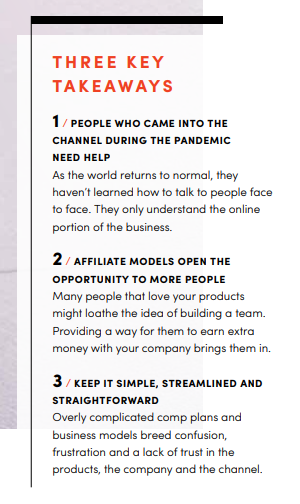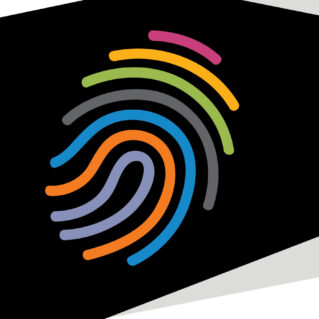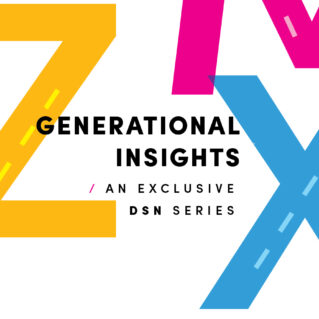As the demographics of those working in the channel continues to shift, how can we keep our field engaged, in touch, enthusiastic and—most importantly—successful?
What now? Let’s recap.
2019 was just a “business as usual” year for all of us. Cruising along, feeling ok about ourselves and tweaking the normal stuff in order to try and grow our businesses.

Then, 2020 happened. March of the year brought panic and uncertainty. How could we ever survive what was happening to us? We questioned everything. Working remotely? All of us? Are you crazy?
But, within a month or so, a funny thing happened. Many of our companies took off. We saw growth we never expected and some of us had never experienced before. It was amazing! Zoom became normal. Supply chain issues happened. But, yet, we thrived. Facebook Live, Instagram, TikTok, WeChat, etc. were all made supremely relevant and part of daily life. We all learned how to connect with people via video, or we thought we did. We learned how to share ideas. We said “you’re on mute” over and over and over again.
Then, while we were patting ourselves on the back and thinking we were smart, mid-2021 happened. The world began to open up. What worked in 2020 was no longer working. But, what worked in 2019 wasn’t working either.
Reset. Rethink. Revamp.
2022 has been the great reset for many of our companies. Watching the financial reports can be depressing. I know of some companies who doubled (or more) in revenue in 2020 only to see all of that growth (and more) go away by early 2022.
From a corporate perspective, you had to face some major questions and make big decisions. You had to figure out what THIS field wanted. Which version of the business were you going to focus on? Pre-2020, post-2020 or both? Or—should you take the opportunity to make major changes and adjust to this “new world” we are all living in?
Think about it, you sat around conference rooms and never-ending Zoom calls trying to make big decisions that would impact—potentially—thousands of lives.

For our distributors, 2019 was normal, too. They were living life and making enough money and loving your products. Some were satisfied; some were not. But, it was normal. 2020 saw some of these same folks sharing your products and making more money than they ever dreamed. They were working from home in their pajamas. Some not even leaving their homes. But, they worked. They used the same technologies you did. Often, they did it better and more effectively. In many cases, we learned from them.
By summer of 2021, lives had been changed forever and, by and large, they were done with being on Zoom all day and night. They were tired of being at home. They were ready to go places, do things and live their life in person, in the moment with their family and friends. They were going to hug people, travel, go to restaurants, concerts and sporting events—enjoy a life they had not had in 18 months or more. Their businesses were put on hold. They were over “the hustle” and wanted to enjoy things again.
Adjusting to a New Normal in Real Time
And, now all those people who came into our businesses in 2020-2021 have no idea how to do the businesses in this more normal world. They didn’t learn how to talk to people about the products face to face. We have often said that “how people are brought in is how they will bring people in”…but they were brought in during a pandemic. How do they adjust to face to face?
Those lives you are impacting—they don’t have conference rooms to sit around in and make big decisions. They don’t have a board of directors to lean on and a support staff or consultants whose job is to research best practices and build new tools and systems. They have families and jobs. They are volunteers who just went through the same ups and downs you did.

On top of that, the competition for ways to make money from their home or from their phones has grown dramatically. Amazon reseller? Great. Easy. How many influencers do you know? Think about it, it wasn’t that long ago that there was no such a thing as “influencers.”
If they have a car and a couple of hours, Uber and Lyft make it simple. Use your phone and drive. The customers are there already. Etsy, Airbnb and so many other options exist, and many of them are currently easier to understand and do.
Through all of that, we still have a large group of people who love our products and our business and many of you are still thriving. Some are just surviving this transition but others are doing just fine.
Ahead of the Learning Curve
After 40+ years in the workforce and over 30 years in this industry, I can say that I’ve learned more in the past three years than at any other time in my life. I’ve watched leaders emerge from the corporate ranks and shine in the face of adversity and change. Others went the other way and didn’t seize the moment. The ones who shined the brightest became beacons of hope and masterful communicators. They provided comfort and motivation to people who were looking for both. The leaders communicated and helped people feel connected, both in the corporate office and in the field. My admiration for those leaders grew exponentially. The world and our industry need more of them.
Today, we find ourselves in a unique place. The old ways are still here and working for some. We also know that people are looking for something that feels right to them. A product and company they trust, even if they don’t want to be overly involved. If they choose to be involved, it’s on their terms and their time now.
More importantly, they want to trust whatever it is they buy and/or share with friends. Often, they may not see themselves as new “business owners,” but they do see themselves as someone who would like to make a few extra dollars. I have found some companies who have emphasized to “start your own business” but are now finding an increasing group of people that are interested in being “affiliates” or “influencers.” And, in doing so, make extra money. It’s a slight mental adjustment, but it seems important to note the difference in outlook and perspective.

A New Model for A New Era
At the recent DSA conference in Provo, there was a fairly large group of company leaders who discussed their interest in adding some sort of affiliate model, designed to attract folks who don’t have an interest in joining a direct selling company. A couple of execs at the table have already implemented an affiliate model with their companies. It seems that, to many prospects, the idea of joining a company is not interesting but sharing the product with friends online or in person sounds pretty good.
In the beginning, they may not have an interest in achieving things like “rank advancements” that we have traditionally built our businesses with. However, they like the idea of getting a friend to purchase product and making 20-30-40 percent on the sale.
That makes sense. They can explain it.
But, show them a stairstep breakaway, and their eyes glaze over. That kind of misunderstanding creates some sort of mistrust. It just doesn’t make sense to them. Far too often, direct selling is not simple.
I have had one company executive recently tell me that, in an effort to reengage some of their legacy people, they showed how to share products and make a few dollars. No need to worry about all the other levels in the comp plan—just share and make money. It is easy to show and attract others. You would have thought their field “saw the light.”

You see, over the years, their people were brought in under the premise that success happened by reaching XYZ level in the comp plan, and the way to do that was by recruiting others to reach that same level. That wasn’t working well before 2020 and sure isn’t working now. Sadly, they were not told that getting and keeping customers would also get them there. It’s slower, but it’s also more reliable. Their data shows that new distributors come and go at an embarrassingly fast rate but happy customers stay around a long time. Once their distributors understood that, it changed the game for them. They are now engaged in product distribution and relieved that the pressure to be on full-time recruiting mode is behind them. Some even said it was refreshing—as if a weight was lifted off their shoulders.
They love the product. They hate recruiting. Yes, they still recruit but they now “Retail to Recruit,” talking with happy customers about how they can benefit by sharing the products, too. It makes sense. It’s simple. It’s organic.
Simple is Hard. But Simple is Successful.
I’m completely fascinated at what the next few years looks like for our industry. The sense I’m getting from a number of executives is the absolute need to simplify. Take away all the elements that cause confusion and—as a result—a lack of trust.
I don’t know that we will all get to the point that our compensation plan can be explained on the front of a 5”x7” piece of paper or short and sweet on a web page—but wouldn’t it be wonderful if we could? Imagine that every person who sees our business understands it quickly and easily. What would that do for your business? For your training? For the trust you are always trying to build?
I’ve said it before, and I will probably say it forever, Simple is Hard, but it’s definitely worth it. People believe what they understand. It’s our job to be great communicators and make more people understand. That principle guided us through the last few years and the ones who get it right will be the real winners of the future.
Paul Adams has been involved in the direct selling channel for more than 30 years. Over the decades, he has worked with hundreds of companies and been a trusted advisor in boardrooms with countless executive teams. From corporate giants to pre-startup, Paul has helped companies invent, reinvent and solidify their messaging, strategy and execution.
From the January/February 2023 issue of Direct Selling News magazine.


